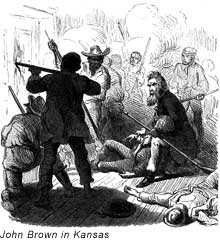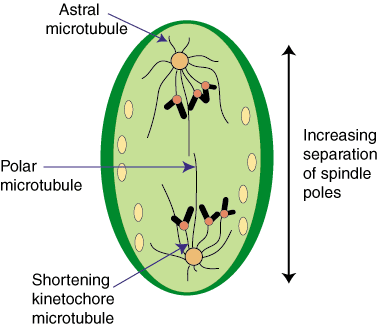Yes, I know it's a science blog. But for now, it's going to be Kate's Social Studies blog. So in honor for Black History month, I'm going to tell you guys about John Brown.

When he was younger, John Brown hated slavery. He saw his friend Cyrus beaten with a shovel. When he moved to Massachusetts in 1846, he helped slaves move to Canada. Then in 1849, he went to New York to help slaves. He did this for six years. Also, he was part of the Underground Railroad.

In 1854 the Kansas-Nebraska act let people vote on weather or not a state could be a slave state or not. Since John Brown really hated slavery he traveled to Kansas to free the state of slavery.

While Brown was in Kansas there were many threats of violence. Many people wanted Kansas to be free and many wanted it be a slave state. On March 30th, 1855, five thousand people from Missouri who protested against Kansas being a free state took over Kansas's voting poles and threatened anyone who wanted it to be free. In 1856, Brown and his sons traveled to Pottawatomie Creek where they murdered 5 people who wanted slavery.

After that, anyone who protested against Kansas was brutally murdered by Brown and his crew. Lots of people though he was an evil person. To people against slavery he was a hero. In 1858, Brown led men to Missouri to free slaves. There was many battles. One that led Brown to his death was the raid on Harper's Ferry.

On October 16th, Brown's men got hostages and begin to march towards Harper's Ferry. People shot at them and Brown knew they were losing but he stayed and fought. The next morning, when the remaining soldiers gathered into a house, they were surrounded by soldiers outside. The soldiers said they would let them surrender and they could live but yet again John Brown refused to surrender. Brown was captured and hung.

Even though some people say that John Brown was a cold hearted murderer, he did those things for the right reason. He was fighting for what he believed in and even though a lot of lives were lost, his actions still helped all of those slaves. Also his life, and many of his men's lives were lost too but they were sacrificing them selves for others to be free.
Yesterday we learned about how awful the Civil War was. Many soldiers didn't get to see their families for over 2 years. If they were lucky, they might get a letter. Also when they got shot in the arm or leg or something, they would have to get it amputated. If they were lucky, they would not get disease. They didn't get food or supplies until 3 days at a time. I really liked how we got to choose what options to do as a soldier.

Bibliography:
https://encrypted-tbn2.google.com/images?q=tbn:ANd9GcQBCHgxlVrZt0LfigEH8uq1Z1koxZZa7pzqgfg-1HzkTsQi1ZhP
https://encrypted-tbn3.google.com/images?q=tbn:ANd9GcSi6zMyVQwyuerDWkQ6CuT3VApm-Cxx8ViEViOGY6kPC7DXtW--IQ
https://encrypted-tbn0.google.com/images?q=tbn:ANd9GcR2IRpxZGz23JxmENm36X5EHI4Gzh9Vr5WEg-KHh27nEcX3ZboP
http://www.sheppardsoftware.com/usaweb/Images/kansas_c_brown.jpg
https://encrypted-tbn3.google.com/images?q=tbn:ANd9GcQHLGMRtxGeRSKe4uSv5Q73bh1d-KqB4Bw2rMMvQIZrThtFWaGe
https://encrypted-tbn2.google.com/images?q=tbn:ANd9GcR5Vs49gY_VmJa71PHLWTtHhqzGyMQklEmrq6LTbL7e_sG2Jdee1A
https://encrypted-tbn0.google.com/images?q=tbn:ANd9GcRKPhl5FxxOIL6fhK4c127zir-dfUxW6do8FEjN_K0iNFQu0lWu
When he was younger, John Brown hated slavery. He saw his friend Cyrus beaten with a shovel. When he moved to Massachusetts in 1846, he helped slaves move to Canada. Then in 1849, he went to New York to help slaves. He did this for six years. Also, he was part of the Underground Railroad.
In 1854 the Kansas-Nebraska act let people vote on weather or not a state could be a slave state or not. Since John Brown really hated slavery he traveled to Kansas to free the state of slavery.
While Brown was in Kansas there were many threats of violence. Many people wanted Kansas to be free and many wanted it be a slave state. On March 30th, 1855, five thousand people from Missouri who protested against Kansas being a free state took over Kansas's voting poles and threatened anyone who wanted it to be free. In 1856, Brown and his sons traveled to Pottawatomie Creek where they murdered 5 people who wanted slavery.

After that, anyone who protested against Kansas was brutally murdered by Brown and his crew. Lots of people though he was an evil person. To people against slavery he was a hero. In 1858, Brown led men to Missouri to free slaves. There was many battles. One that led Brown to his death was the raid on Harper's Ferry.
On October 16th, Brown's men got hostages and begin to march towards Harper's Ferry. People shot at them and Brown knew they were losing but he stayed and fought. The next morning, when the remaining soldiers gathered into a house, they were surrounded by soldiers outside. The soldiers said they would let them surrender and they could live but yet again John Brown refused to surrender. Brown was captured and hung.
Even though some people say that John Brown was a cold hearted murderer, he did those things for the right reason. He was fighting for what he believed in and even though a lot of lives were lost, his actions still helped all of those slaves. Also his life, and many of his men's lives were lost too but they were sacrificing them selves for others to be free.
Yesterday we learned about how awful the Civil War was. Many soldiers didn't get to see their families for over 2 years. If they were lucky, they might get a letter. Also when they got shot in the arm or leg or something, they would have to get it amputated. If they were lucky, they would not get disease. They didn't get food or supplies until 3 days at a time. I really liked how we got to choose what options to do as a soldier.
Bibliography:
https://encrypted-tbn2.google.com/images?q=tbn:ANd9GcQBCHgxlVrZt0LfigEH8uq1Z1koxZZa7pzqgfg-1HzkTsQi1ZhP
https://encrypted-tbn3.google.com/images?q=tbn:ANd9GcSi6zMyVQwyuerDWkQ6CuT3VApm-Cxx8ViEViOGY6kPC7DXtW--IQ
https://encrypted-tbn0.google.com/images?q=tbn:ANd9GcR2IRpxZGz23JxmENm36X5EHI4Gzh9Vr5WEg-KHh27nEcX3ZboP
http://www.sheppardsoftware.com/usaweb/Images/kansas_c_brown.jpg
https://encrypted-tbn3.google.com/images?q=tbn:ANd9GcQHLGMRtxGeRSKe4uSv5Q73bh1d-KqB4Bw2rMMvQIZrThtFWaGe
https://encrypted-tbn2.google.com/images?q=tbn:ANd9GcR5Vs49gY_VmJa71PHLWTtHhqzGyMQklEmrq6LTbL7e_sG2Jdee1A
https://encrypted-tbn0.google.com/images?q=tbn:ANd9GcRKPhl5FxxOIL6fhK4c127zir-dfUxW6do8FEjN_K0iNFQu0lWu


